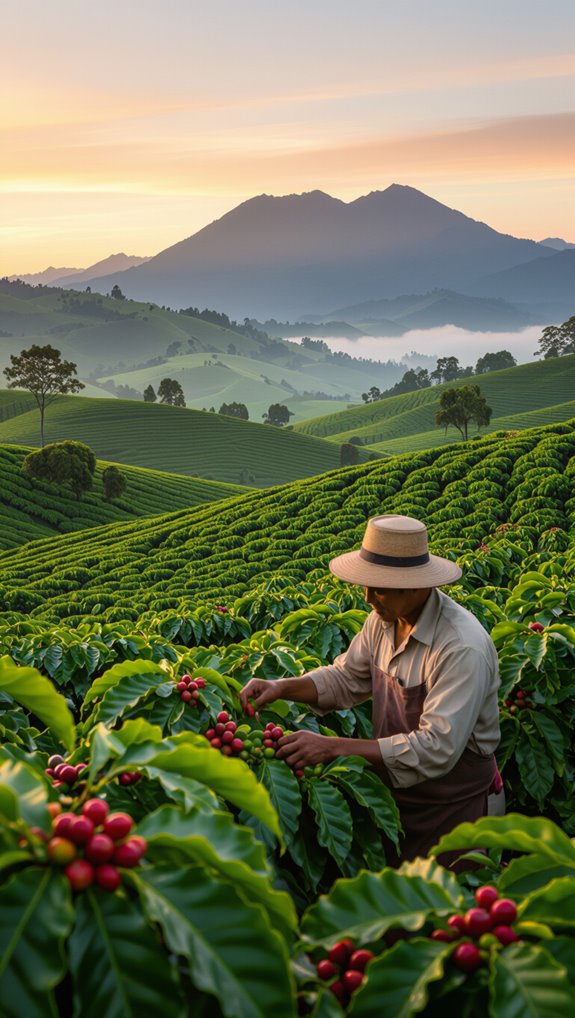Ever wonder where your morning coffee actually comes from before it lands in your cup? Most people know coffee starts as beans, but few realize those “beans” are actually seeds from coffee cherries that only grow in specific tropical regions around the world. Understanding the origins of your coffee can completely transform how you appreciate each sip.
This post breaks down everything you need to know about where coffee beans come from. You’ll discover the Coffee Belt—the narrow tropical band that produces all the world’s coffee—and learn how different regions from Ethiopian highlands to Colombian mountains create distinct flavors in your brew. By the end, you’ll understand why geography matters so much to your daily cup and what to look for when choosing your next bag of beans.
Table of Contents
Where Do Coffee Beans Actually Come From
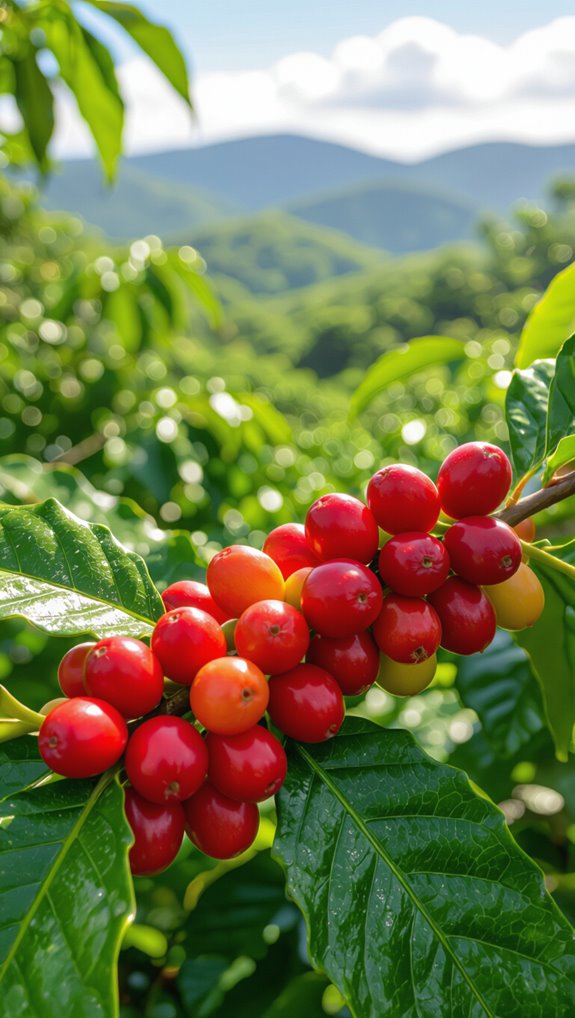
Coffee beans aren’t actually beans at all—they’re seeds nestled inside bright red or purple coffee cherries that grow on trees in specific tropical and subtropical regions around the globe.
These cherries primarily flourish in what’s known as the “Coffee Belt,” stretching across Africa, South America, Central America, and parts of Asia.
The two main varieties, Arabica and Robusta, each thrive in different elevations and climates. Arabica prefers cooler, higher altitudes like Ethiopia’s highlands, while Robusta grows well in warmer, lower-elevation regions like Vietnam’s landscapes. The vast majority of coffee trees are cultivated within 25 degrees north and south of the Equator, where specific microclimates and soil conditions support optimal growth.
The Coffee Belt: Where All Coffee Grows
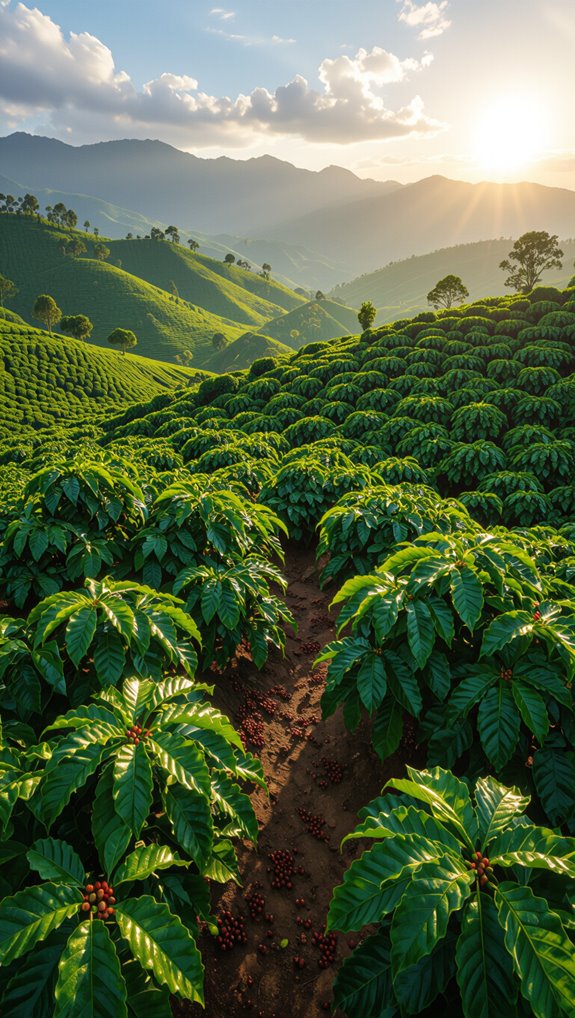
Although coffee grows in numerous regions worldwide, nearly all commercial coffee is cultivated within a specific geographic zone known as the Coffee Belt. This remarkable band stretches between the Tropics of Cancer and Capricorn, spanning over 70 countries across multiple continents. Volcanic soil composition plays a critical role in creating nutrient-rich environments that enhance coffee bean quality and flavor development.
The belt’s unique environmental conditions—including ideal elevation, consistent temperatures, and volcanic soils—create the perfect environment for coffee cultivation.
From Brazil’s lush highlands to Ethiopia’s mountainous landscapes, this geographic zone produces over 70% of the world’s coffee, offering incredible diversity in flavor, aroma, and character.
What Countries Produce the Most Coffee Beans
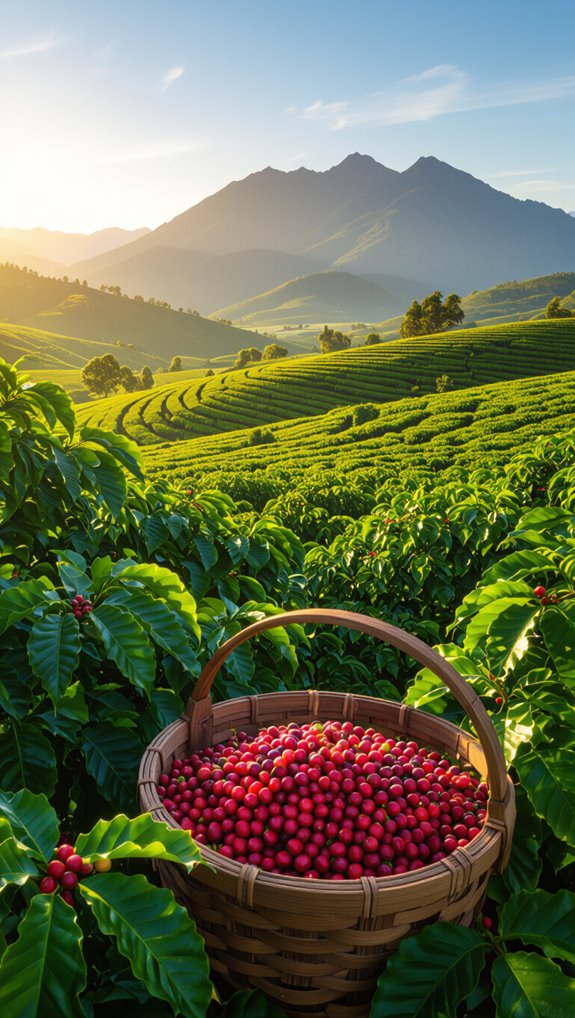
The global coffee landscape is dominated by a handful of powerhouse nations that fuel the world’s caffeine addiction. Brazil leads the pack, producing a whopping 39-45% of global coffee, followed by Vietnam‘s robust Robusta beans. Climate change challenges are increasingly impacting these crucial coffee-producing regions, threatening long-term agricultural sustainability.
Here’s what makes these coffee giants tick:
- Brazil’s Minas Gerais region churns out around 3 million tons annually
- Vietnam specializes in Robusta, contributing 1.7 million tons each year
- Colombia crafts high-quality Arabica with 792,000 tons of production
- Ethiopia and Indonesia round out the top five, each bringing unique flavor profiles
These countries aren’t just growing coffee—they’re driving a global industry.
How African Coffee Beans Taste Different From Others
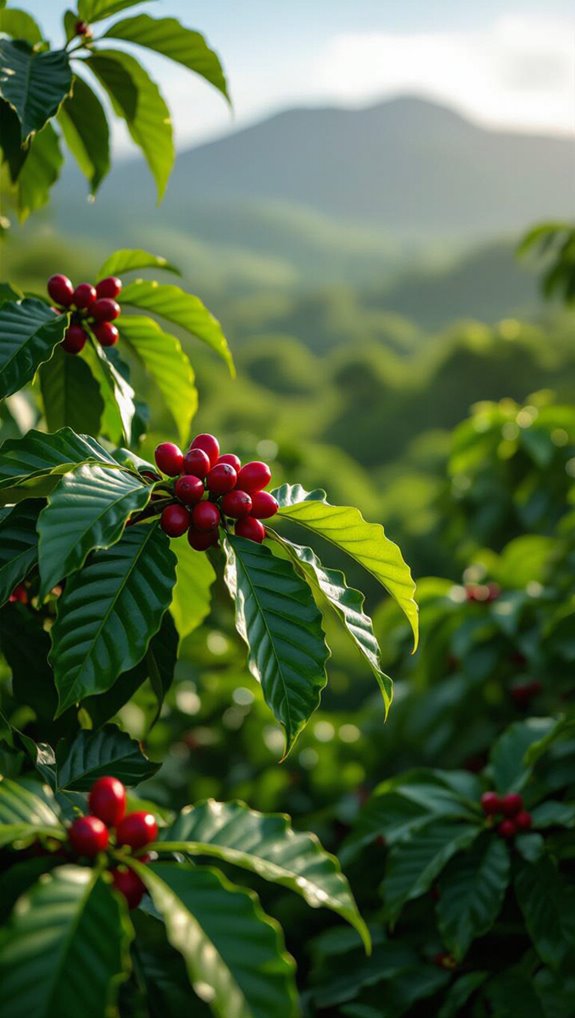
After mapping out global coffee production, let’s zoom in on what makes African beans stand out in the world of specialty coffee. These beans offer a vibrant flavor profile that’s worlds apart from other origins, bursting with high acidity, bright citrusy notes, and complex fruity undertones.
From Ethiopian floral hints to Kenyan wine-like berry flavors, African coffees deliver an extraordinary sensory experience. Each region contributes unique characteristics—whether it’s the velvety body, spicy undertones, or remarkable processing methods that transform simple beans into liquid art.
The result? A cup that’s not just a beverage, but a journey through Africa’s diverse coffee landscapes.
Why Latin American Coffee Is So Popular
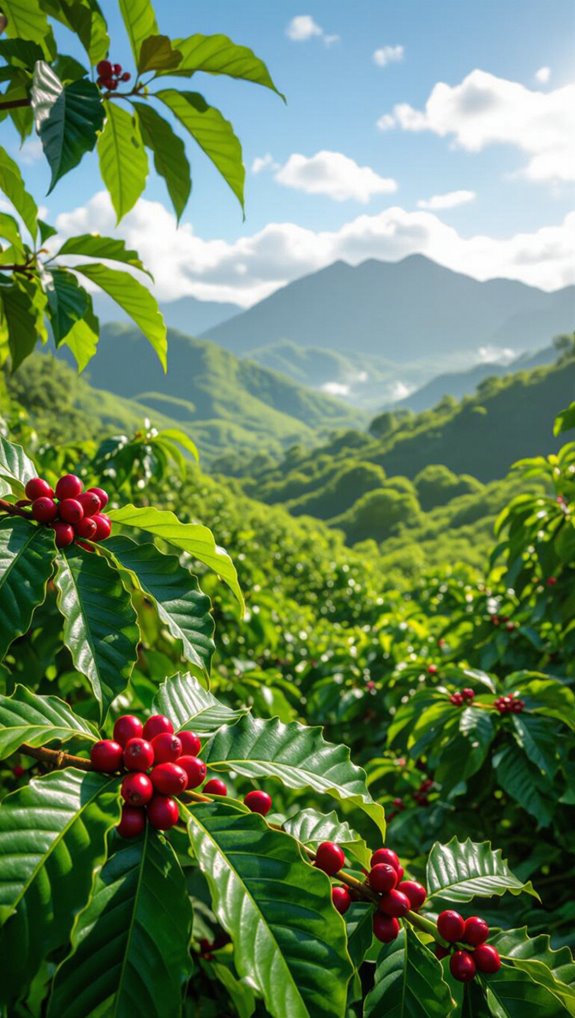
Flavor Architects: Latin American coffee’s global popularity stems from its remarkable ability to deliver consistently high-quality, versatile beans that satisfy diverse palates worldwide. Here’s why these beans reign supreme:
- Ideal Growing Conditions: High-altitude mountains, volcanic soils, and tropical climates create perfect arabica environments.
- Flavor Diversity: From Brazil’s nutty, chocolatey profiles to Colombia’s smooth, balanced beans, there’s something for every taste.
- Global Market Dominance: Producing 60% of the world’s coffee, Latin America drives global supply and quality standards.
- Sustainable Innovation: Commitment to traceability, direct trade, and adaptive farming ensures continued excellence.
These factors make Latin American coffee an unrivaled global favorite.
Coffee Growing Regions in Asia and Pacific
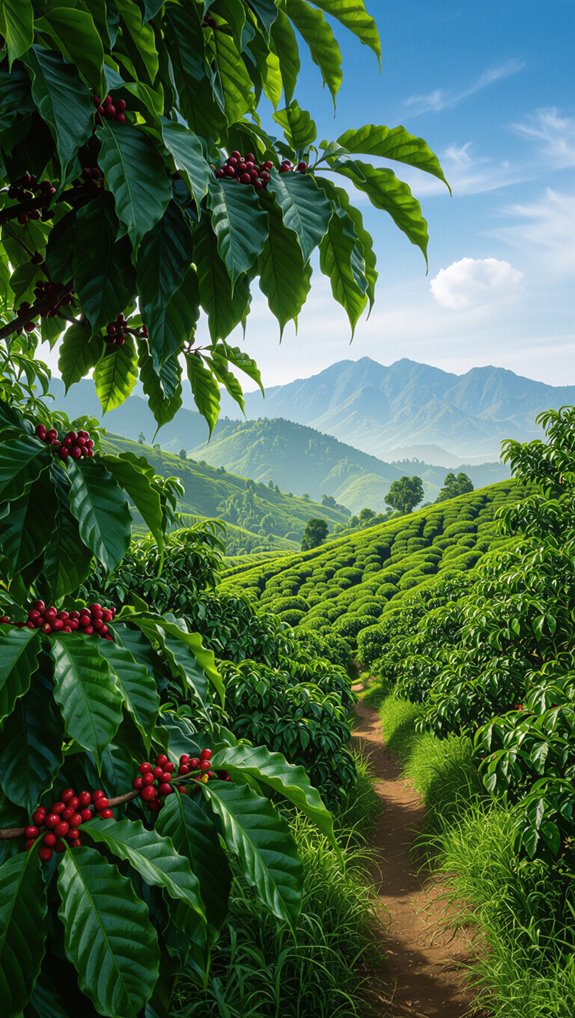
While Latin America dominates global coffee production, Asia and the Pacific have emerged as powerhouse regions with unique, vibrant coffee landscapes that’ll surprise even seasoned coffee enthusiasts.
Vietnam leads the pack as the second-largest global producer, specializing in bold Robusta beans from its Central Highlands. Indonesia follows with its distinctive wet-hulled processing, creating earthy Sumatra Mandheling and exotic Kopi Luwak varieties.
Countries like India, Laos, and Papua New Guinea contribute diverse flavor profiles, leveraging high-altitude tropical climates. This region’s coffee scene is rapidly evolving, driven by growing middle-class consumption and innovative local coffee cultures.
What Are Arabica and Robusta Coffee Beans
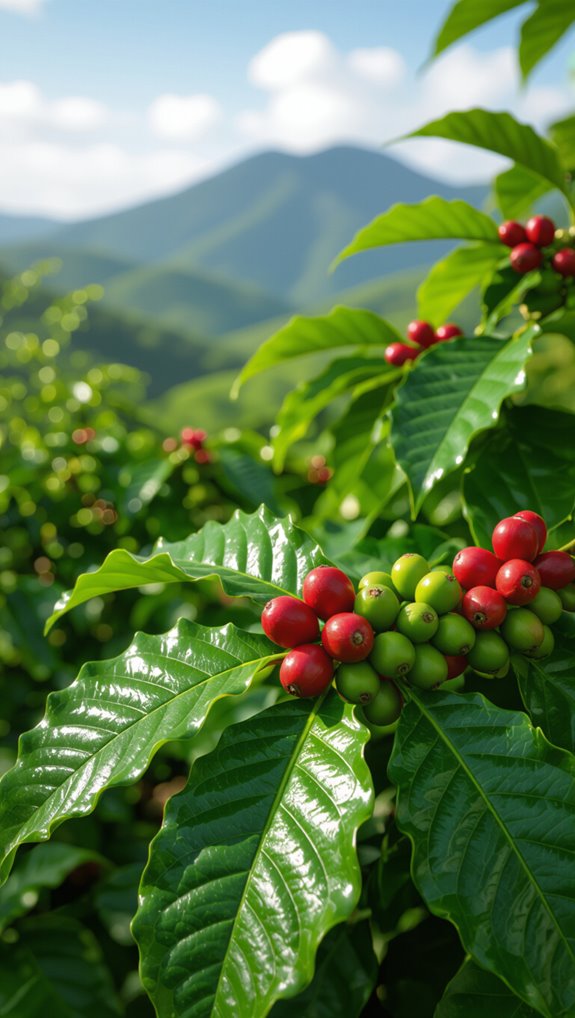
The coffee world is divided into two primary bean superstars: Arabica and Robusta, each with its own personality and flavor profile that coffee lovers need to know. These African-born beans dominate global coffee production, offering distinct characteristics that impact your daily brew:
- Arabica: Sweet, complex flavor with fruity notes, grown at high altitudes in regions like Ethiopia and Brazil
- Robusta: Strong, bitter taste with higher caffeine, cultivated at lower elevations in Vietnam and Indonesia
- Flavor Difference: Arabica contains more sugars and lipids, creating a smoother experience
- Market Share: Arabica represents 60-70% of global coffee production
Each bean tells a unique story in your cup.
The Journey From Coffee Farm to Your Cup
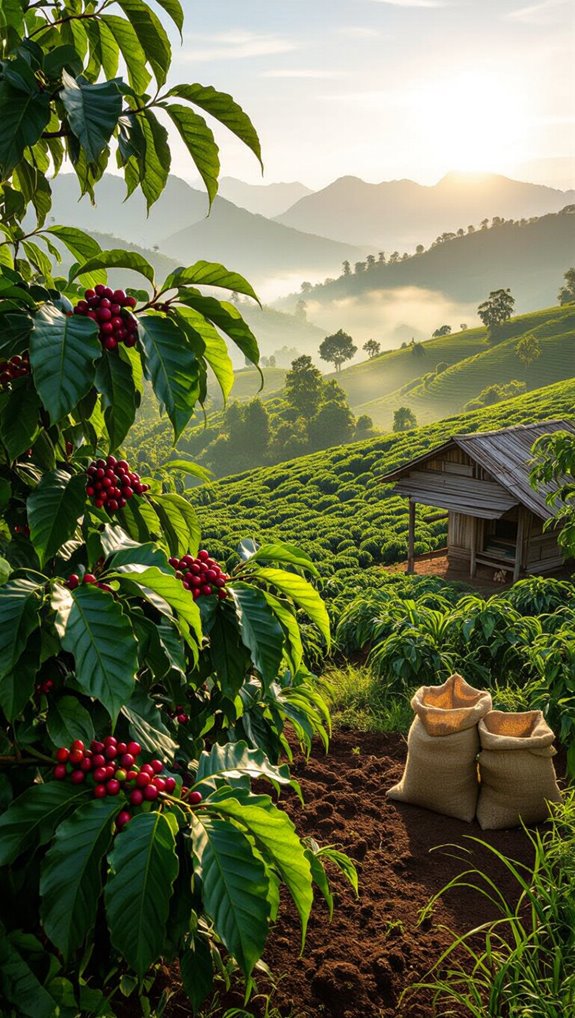
From bean to brew, coffee’s transformative journey is a fascinating expedition that turns humble agricultural products into the world’s most beloved beverage.
Coffee begins with careful harvesting of ripe red cherries, often hand-picked to ensure quality. Producers then process these cherries using techniques like washed, natural, or honey methods, each influencing the final flavor profile.
At the mill, beans are hulled, sorted, and prepared as green coffee. Roasters then apply heat, developing complex flavors through precise temperature and time adjustments.
Finally, grinding and brewing transform these roasted beans into the aromatic cup we cherish.
How Climate and Altitude Affect Coffee Bean Flavor
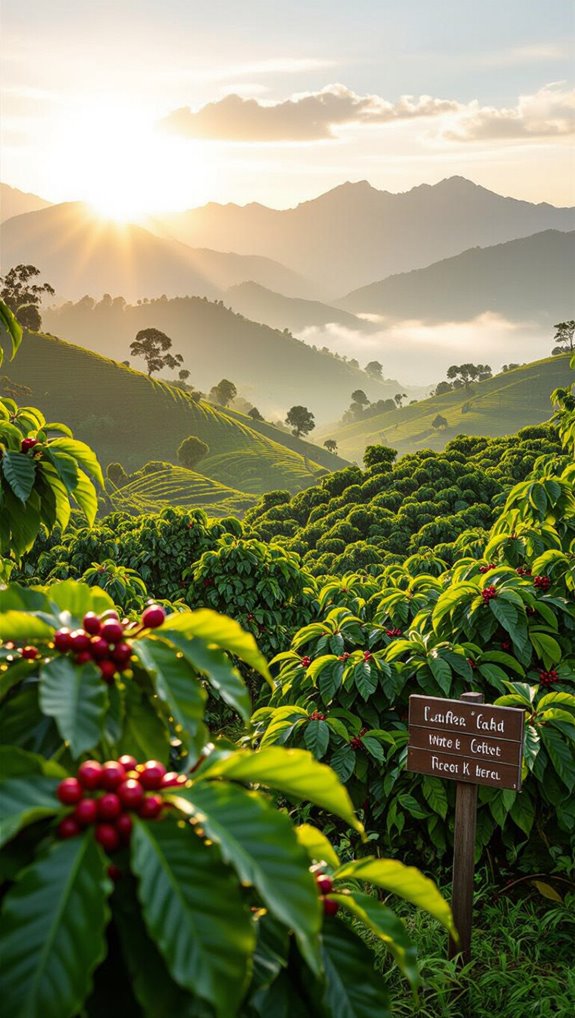
After exploring coffee’s journey from farm to cup, let’s uncover how nature’s subtle influences shape your morning brew’s flavor profile. Coffee’s taste is a delicate dance of environmental factors:
- Altitude slows cherry maturation, developing complex flavor compounds
- Temperature impacts bean size and metabolite production
- Water stress directly influences sugar formation and acidity
- Sunlight exposure modulates sensory attributes through metabolite accumulation
These intricate interactions determine whether your coffee delivers a vibrant, fruity experience or a flat, uninspired taste. High-altitude Arabica beans, grown in carefully balanced climatic conditions, consistently produce the most nuanced and sought-after flavor profiles that coffee enthusiasts crave.
Which Coffee Origin Should You Try First
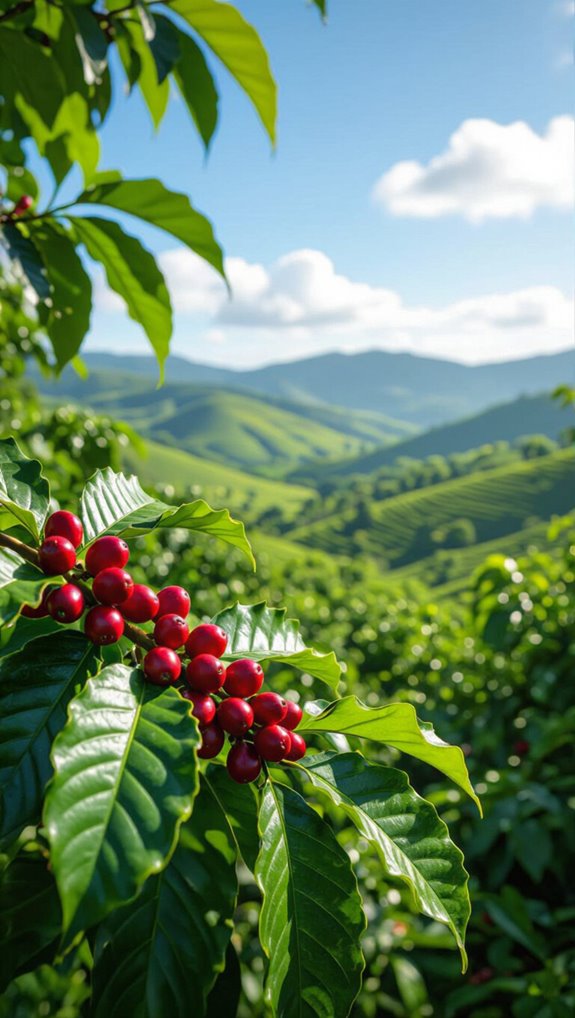
If you’re looking to dive into the world of specialty coffee, let’s kick off your flavor journey by picking the perfect origin that’ll make your taste buds dance.
For beginners, I recommend starting with Colombian coffee—it’s the ultimate gateway bean. Its balanced flavor profile offers caramel sweetness and mild acidity that won’t overwhelm your palate.
Want something more adventurous? Ethiopian Yirgacheffe brings fruity, floral notes that’ll intrigue your senses.
Brazilian beans offer a classic chocolate-nutty experience for traditionalists.
Each origin tells a unique story, so don’t be afraid to explore and find your personal coffee love affair.
Frequently Asked Questions
Can I Grow My Own Coffee Beans at Home?
Yes, you can grow coffee beans at home! I’ve found it challenging but rewarding. You’ll need patience, indirect light, consistent moisture, and the right temperature. It takes months for germination and years before your first harvest.
How Long Does It Take for a Coffee Plant to Produce Beans?
It’ll take 3 to 5 years for my coffee plant to produce beans. I’ll need patience during the early growth stages, but once mature, I can expect about a pound of roasted coffee annually from each healthy bush.
Are Organic Coffee Beans Better Than Regular Coffee Beans?
I believe organic coffee beans are healthier and more environmentally friendly, but they’re not necessarily superior in taste or quality. They offer fewer pesticides and better ecological practices, though they’re typically more expensive than regular coffee beans.
Do Different Coffee Bean Origins Have Different Caffeine Levels?
Yes, coffee bean origins significantly impact caffeine levels. Robusta beans from lower-altitude regions like Vietnam typically have higher caffeine (2.2-2.7%) compared to Arabica beans from high-altitude areas like Ethiopia, which contain less caffeine (1.1-1.7%).
What’s the Most Expensive Coffee Bean in the World?
Based on my research, the Elida Geisha Natural Torre from Panama is currently the world’s most expensive coffee, recently selling at auction for over $10,000 per kilogram, far surpassing other rare coffee varieties like Kopi Luwak.
In Conclusion
Coffee beans come from a fascinating belt of regions around the world, each contributing its own character to your morning cup. From the birthplace of coffee in Ethiopia’s highlands to the sprawling plantations of South America and Southeast Asia, understanding where coffee beans come from enriches every sip you take. The soil, altitude, and climate of each origin shape the flavors you taste—whether that’s the bright, fruity notes of African beans or the chocolatey smoothness of South American varieties.
Now that you know the journey these beans take from tropical farms to your kitchen, you’re ready to make the most of them. The right brewing method can highlight the unique qualities of beans from different origins, and having a quality coffee machine makes all the difference. Check out our coffee machine reviews to find options that will help you unlock the full potential of beans from around the world, whether you prefer espresso, pour-over, or French press.

